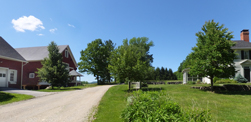

Felt/Tobey/Scott Barn (1780s) The Felt/Tobey/Scott Barn was part of one of Temple’s earliest farms, owned by pioneer settler Peter Felt. In 1903 the property was purchased by Charles Tobey, who dubbed the place “Colonial Farm” and raised prize-winning White Orringtons – one of which laid a record-breaking 251 eggs in a single year! Tobey quickly became absorbed in Temple life and politics, serving as selectman and chairman of the school board. He served three terms in the N.H. Legislature, and in 1924 was elected to the State Senate. Four years later he was elected governor, and in 1938 he won a seat in the U.S. Senate for the first of three terms. On a warm August day in 1962, Ken and Martha Scott and their two sons left Wayland, Massachusetts to move into the Senator Tobey farm in Temple (pop. at the time 365). Mark and Wynn spent the weeks prior to attending Temple's three room elementary school exploring the property. In the old barn they found remnants of Tobey's tenure, including an old player piano, an antiquated pickup truck, books and papers in a makeshift office, and various penciled notations scrawled on the walls by the Senator to mark such noteworthy events as the arrival of the first bluebirds, visits from relatives, and the death of his wife Francelia and other loved ones. Over the years, the barn hosted numerous games with neighboring children, stored hay cut from the surrounding fields, housed two horses, and witnessed many a rough basketball scrimmage between Mark and his father. Mother Martha deserves credit for winning a ten year battle to rid the barn of an invasion of bats in the 1990s. The barn's wet location caused floors to sag and sills to rot. Initially, the Scotts periodically employed neighbor Perry Maynard to jack up and level the foundation, but it was not until the recent extensive repairs by Ken Quinn that the barn's vulnerabilities were fully corrected. Those repairs were arranged by Mark, now 63, who plans to return to his childhood home in retirement from Pennsylvania. Notes on the 21st Century Restoration The original builders of this ancient post-and-beam structure laid the sills across a trench filled with fieldstone. The trench was only a couple of feet in depth, allowing the building to move up and down with the freeze-thaw cycle, and I am quite sure it was all dug with a pick and shovel. Anyone who has ever sunk a spade into good old New England hardpan will understand why the trench was so shallow! The earth under the barn was a natural slope with about a foot of clearance on the north wall and four feet on the south side. Geddies Building movers came in from Bow N.H. and slid 40 foot I-beams under the barn, jacked it up ten feet, and cribbed it up on the I-beams so we could excavate and pour footers and foundation walls. Phil Marchuk from Temple and Patrick Naglie from Peterborough did the excavation and earth work required, working around the cribbing piles and the barn over them. Both excellent operators, they were not by any means afraid of the hard manual labor required. They also were the work force to replace the sills and floor joist and other carpentry work needed on the project. Thanks to the skill and hard work of these two talented men, the whole project was completed with only a three man work crew. When the excavation was ready Hunter Foundations from Marlborough, N.H. poured the footers and the foundation. Some of the sills we replaced while the building was jacked up, and some we replaced after it was settled onto a new and sound foundation, good for another two centuries. Kenneth A. Quinn
|
||







